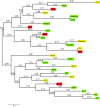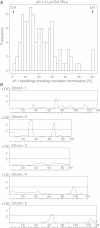Accession-specific modifiers act with ZWILLE/ARGONAUTE10 to maintain shoot meristem stem cells during embryogenesis in Arabidopsis
- PMID: 24252363
- PMCID: PMC4046819
- DOI: 10.1186/1471-2164-14-809
Accession-specific modifiers act with ZWILLE/ARGONAUTE10 to maintain shoot meristem stem cells during embryogenesis in Arabidopsis
Abstract
Background: Stem cells located in the centre of the shoot apical meristem are required for the repetitive formation of new organs such as leaves, branches and flowers. In Arabidopsis thaliana, the ZWILLE/PINHEAD/AGO10 (ZLL) gene encodes a member of the ARGONAUTE (AGO) protein family and is required to maintain shoot meristem stem cells during embryogenesis. In the Landsberg erecta (Ler) acession, ZLL is essential for stem cell maintenance, whereas in the Columbia (Col) accession its requirement appears masked by genetic modifiers. The genetic basis for this variation has remained elusive.
Results: To understand the impact of natural variation on shoot stem cell maintenance, we analysed 28 wild-type Arabidopsis accessions from around the world and show that ZLL function is essential for stem cell maintenance in accessions mainly originating from Germany, but is dispensable for accessions from other regions. Quantitative Trait Loci (QTL) mapping using Ler/Col recombinant inbred lines indicated that at least five genomic regions, referred to as FLETSCHE (FHE) 1-5, modify ZLL function in stem cell maintenance. Characterisation of Col zll near isogenic lines confirmed that the major QTL, FHE2, is preferentially maintained as a Ler allele in seedlings lacking stem cells, suggesting that this region harbours an important modifier of ZLL function. Comparison of torpedo-stage embryo expression profiles to QTL map data revealed candidate FHE genes, including the Arabidopsis Cyclophilin-40 homologue SQUINT (SQN), and functional studies revealed a previously uncharacterised role for SQN in stem cell regulation.
Conclusions: Multiple genetic modifiers from different Arabidopsis accessions influence the role of ZLL in embryonic stem cell maintenance. Of the five FHE loci modifying stem cell maintenance in Ler-0 and Col-0, FHE2 was the most prominent and was tightly linked to the SQN gene, which encodes a cofactor that supports AGO1 activity. SQN shows variable embryonic expression levels between accessions and altered ZLL-dependency in transgenic assays, confirming a key role in stem cell maintenance. Reduced SQN expression levels in Col-0 correlate with transposon insertions adjoining the transcriptional start site, which may contribute to stem cell maintenance in other ZLL-independent accessions.
Figures





References
Publication types
MeSH terms
Substances
LinkOut - more resources
Full Text Sources
Other Literature Sources
Medical
Molecular Biology Databases

